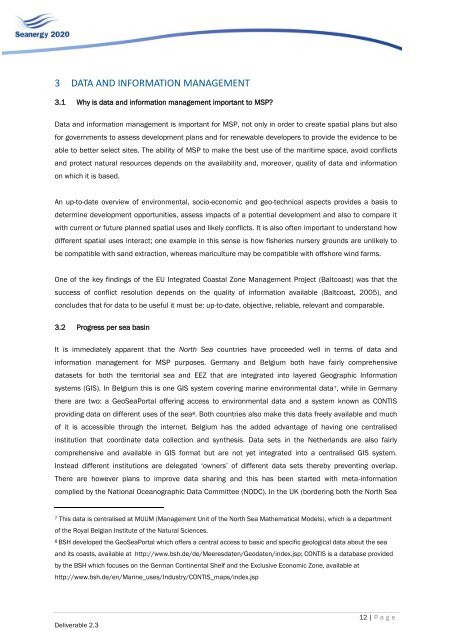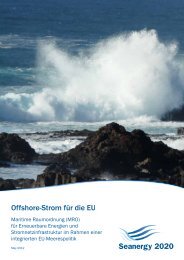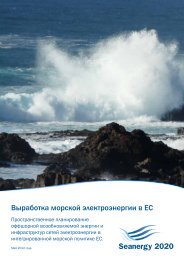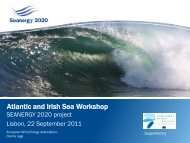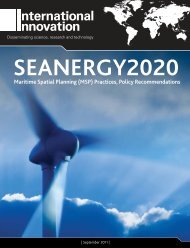Comparative analysis of Maritime Spatial Planning ... - Seanergy 2020
Comparative analysis of Maritime Spatial Planning ... - Seanergy 2020
Comparative analysis of Maritime Spatial Planning ... - Seanergy 2020
You also want an ePaper? Increase the reach of your titles
YUMPU automatically turns print PDFs into web optimized ePapers that Google loves.
3 DATA AND INFORMATION MANAGEMENT3.1 Why is data and information management important to MSP?Data and information management is important for MSP, not only in order to create spatial plans but als<strong>of</strong>or governments to assess development plans and for renewable developers to provide the evidence to beable to better select sites. The ability <strong>of</strong> MSP to make the best use <strong>of</strong> the maritime space, avoid conflictsand protect natural resources depends on the availability and, moreover, quality <strong>of</strong> data and informationon which it is based.An up-to-date overview <strong>of</strong> environmental, socio-economic and geo-technical aspects provides a basis todetermine development opportunities, assess impacts <strong>of</strong> a potential development and also to compare itwith current or future planned spatial uses and likely conflicts. It is also <strong>of</strong>ten important to understand howdifferent spatial uses interact; one example in this sense is how fisheries nursery grounds are unlikely tobe compatible with sand extraction, whereas mariculture may be compatible with <strong>of</strong>fshore wind farms.One <strong>of</strong> the key findings <strong>of</strong> the EU Integrated Coastal Zone Management Project (Baltcoast) was that thesuccess <strong>of</strong> conflict resolution depends on the quality <strong>of</strong> information available (Baltcoast, 2005), andconcludes that for data to be useful it must be: up-to-date, objective, reliable, relevant and comparable.3.2 Progress per sea basinIt is immediately apparent that the North Sea countries have proceeded well in terms <strong>of</strong> data andinformation management for MSP purposes. Germany and Belgium both have fairly comprehensivedatasets for both the territorial sea and EEZ that are integrated into layered Geographic Informationsystems (GIS). In Belgium this is one GIS system covering marine environmental data 7 , while in Germanythere are two: a GeoSeaPortal <strong>of</strong>fering access to environmental data and a system known as CONTISproviding data on different uses <strong>of</strong> the sea 8 . Both countries also make this data freely available and much<strong>of</strong> it is accessible through the internet. Belgium has the added advantage <strong>of</strong> having one centralisedinstitution that coordinate data collection and synthesis. Data sets in the Netherlands are also fairlycomprehensive and available in GIS format but are not yet integrated into a centralised GIS system.Instead different institutions are delegated „owners‟ <strong>of</strong> different data sets thereby preventing overlap.There are however plans to improve data sharing and this has been started with meta-informationcomplied by the National Oceanographic Data Committee (NODC). In the UK (bordering both the North Sea7 This data is centralised at MUUM (Management Unit <strong>of</strong> the North Sea Mathematical Models), which is a department<strong>of</strong> the Royal Belgian Institute <strong>of</strong> the Natural Sciences.8 BSH developed the GeoSeaPortal which <strong>of</strong>fers a central access to basic and specific geological data about the seaand its coasts, available at http://www.bsh.de/de/Meeresdaten/Geodaten/index.jsp; CONTIS is a database providedby the BSH which focuses on the German Continental Shelf and the Exclusive Economic Zone, available athttp://www.bsh.de/en/Marine_uses/Industry/CONTIS_maps/index.jspDeliverable 2.312 | P a g e


